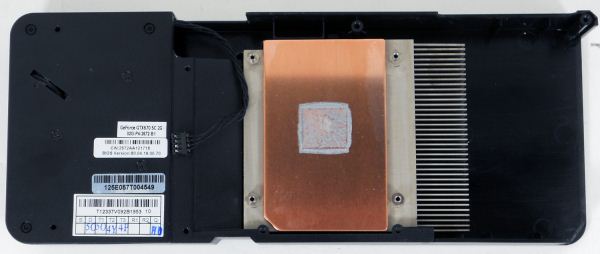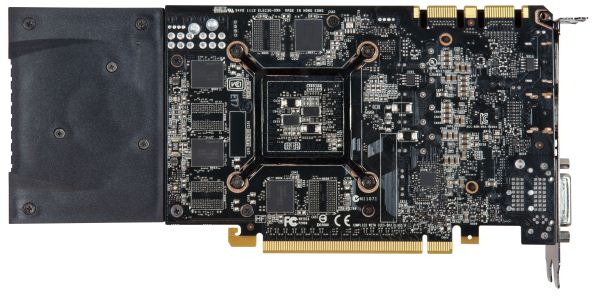NVIDIA GeForce GTX 670 Review Feat. EVGA: Bringing GK104 Down To $400
by Ryan Smith on May 10, 2012 9:00 AM ESTMeet The GeForce GTX 670
Because of the relatively low power consumption of GK104 relative to past high-end NVIDIA GPUs, NVIDIA has developed a penchant for small cards. While the GTX 680 was a rather standard 10” long, NVIDIA also managed to cram the GTX 690 into the same amount of space. Meanwhile the GTX 670 takes this to a whole new level.
We’ll start at the back as this is really where NVIDIA’s fascination with small size makes itself apparent. The complete card is 9.5” long, however the actual PCB is far shorter at only 6.75” long, 3.25” shorter than the GTX 680’s PCB. In fact it would be fair to say that rather than strapping a cooler onto a card, NVIDIA strapped a card onto a cooler. NVIDIA has certainly done short PCBs before – such as with one of the latest GTX 560 Ti designs – but never on a GTX x70 part before. But given the similarities between GK104 and GF114, this isn’t wholly surprising, if not to be expected.
In any case this odd pairing of a small PCB with a large cooler is no accident. With a TDP of only 170W NVIDIA doesn’t necessarily need a huge PCB, but because they wanted a blower for a cooler they needed a large cooler. The positioning of the GPU and various electronic components meant that the only place to put a blower fan was off of the PCB entirely, as the GK104 GPU is already fairly close to the rear of the card. Meanwhile the choice of a blower seems largely driven by the fact that this is an x70 card – NVIDIA did an excellent job with the GTX 560 Ti’s open air cooler, which was designed for the same 170W TDP, so the choice is effectively arbitrary from a technical standpoint (there’s no reason to believe $400 customers are any less likely to have a well-ventilated case than $250 buyers). Accordingly, it will be NVIDIA’s partners that will be stepping in with open air coolers of their own designs.
Starting as always at the top, as we previously mentioned the reference GTX 670 is outfitted with a 9.5” long fully shrouded blower. NVIDIA tells us that the GTX 670 uses the same fan as the GTX 680, and while they’re nearly identical in design, based on our noise tests they’re likely not identical. On that note unlike the GTX 680 the fan is no longer placed high to line up with the exhaust vent, so the GTX 670 is a bit more symmetrical in design than the GTX 680 was.

Note: We dissaembled the virtually identical EVGA card here instead
Lifting the cooler we can see that NVIDIA has gone with a fairly simple design here. The fan vents into a block-style aluminum heatsink with a copper baseplate, providing cooling for the GPU. Elsewhere we’ll see a moderately sized aluminum heatsink clamped down on top of the VRMs towards the front of the card. There is no cooling provided for the GDDR5 RAM.

Note: We dissaembled the virtually identical EVGA card here instead
As for the PCB, as we mentioned previously due to the lower TDP of the GTX 670 NVIDIA has been able to save some space. The VRM circuitry has been moved to the front of the card, leaving the GPU and the RAM towards the rear and allowing NVIDIA to simply omit a fair bit of PCB space. Of course with such small VRM circuitry the reference GTX 670 isn’t built for heavy overclocking – like the other GTX 600 cards NVIDIA isn’t even allowing overvolting on reference GTX 670 PCBs – so it will be up to partners with custom PCBs to enable that kind of functionality. Curiously only 4 of the 8 Hynix R0C GDDR5 RAM chips are on the front side of the PCB; the other 4 are on the rear. We typically only see rear-mounted RAM in cards with 16/24 chips, as 8/12 will easily fit on the same side.
Elsewhere at the top of the card we’ll find the PCIe power sockets and SLI connectors. Since NVIDIA isn’t scrambling to save space like they were with the GTX 680, the GTX 670’s PCIe power sockets are laid out in a traditional side-by-side manner. As for the SLI connectors, since this is a high-end GeForce card NVIDIA provides 2 connectors, allowing for the card to be used in 3-way SLI.
Finally at the front of the card NVIDIA is using the same I/O port configuration and bracket that we first saw with the GTX 680. This means 1 DL-DVI-D port, 1 DL-DVI-I port, 1 full size HDMI 1.4 port, and 1 full size DisplayPort 1.2. This also means the GTX 670 follows the same rules as the GTX 680 when it comes to being able to idle with multiple monitors.
















414 Comments
View All Comments
B-Unit1701 - Saturday, May 12, 2012 - link
So we now price GPUs on an arbitrary 'tier' ranking instead of based on performance? Awesome.CeriseCogburn - Sunday, May 13, 2012 - link
The tier ranking is based upon performance, with the solidness of many months of pricing solidifying those tier placements.Way to go fella, being that stupid shouldn't be a hobby or a habit.
euler007 - Thursday, May 10, 2012 - link
I've been waiting for the 680 to come in stock for weeks.It's pretty sad when you need to snipe newegg and the manufacturer's stores (or pay 10% markups on amazon stores) to buy a product.
Morg. - Thursday, May 10, 2012 - link
The 680 is a lie, it'll reach production quantities in 3 months maybe ;)CeriseCogburn - Friday, May 11, 2012 - link
Just the EVGA 680 has sold more than the 7850 and 7870 combined at newegg.So despite 680 supply constraint, it is doing better than amd's entire 78xx lineup there.
ROFL - now that's sadness for amd fans
SlyNine - Saturday, May 12, 2012 - link
You're basing this on verified buyers on neweggs reviewed cards. Logic doesn't get much more flawed then that.CeriseCogburn - Sunday, May 13, 2012 - link
Logic doesn't get much better than that, nor does accuracy - it's worked for years now, just because you are absolutely clueless does not make it invalid.Crazyeyeskillah - Thursday, May 10, 2012 - link
if you can't afford it, it's your own fault. Every time I see a classless arrogant self entitled poster complaining about the pricing of all these new generations it makes me sick. There is a card in your price range, whatever your budget is. Just because they make expensive hardware doesn't mean it's for you, so why are you screaming about it constantly? I'm not screaming that I can't afford a 7 series BMW so don't embarass yourself. It makes you look foolish at best. People will agree with you because they are also in the throngs of life's underachievers who think they are entitled to a lifestyle they haven't worked for. If you really want it, save for it. I'm happy to pay for an ultra premium product that delivers an experience that I can say is truly enjoyable.THEY NEED TO LOWER THE PRICE OF f-35's NOW CRY CRY
cek
chizow - Thursday, May 10, 2012 - link
So if you bought a BMW 7 series for the last 15 years, and then BMW tried selling you a 3 series labeled and priced as a 7 series, you'd just buy it at 7 prices no questions asked and be satisfied?If so, you'd certainly be entitled to everything born of ignorance.
RussianSensation - Thursday, May 10, 2012 - link
It's hilarious how people still keep using this argument: "If you can't afford it, don't complain about price." Many of us can afford the card. The main discussion at hand is that NV released a mid-range/upper mid-range line-up of chips that's a replacement for GTX560Ti and priced them at $400-500. Can you imagine if this was happening since GeForce 2 days, how much slower would the current cards be?Even the reviewer noted that this is the least performance improvement from a new architecture + full node shrink in the history of NV. GTX670/680 are still good cards, but it doesn't change the fact that they aren't true flagship replacements for GTX480/580. Otherwise, AMD/NV will just launch 25-30% faster new generations every 18 months and we are supposed to eat it up for $500? Hopefully HD8000 and GTX780 will remedy the situation :)